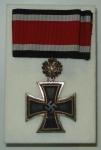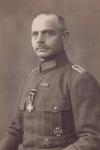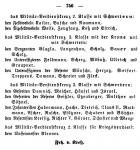-
Posts
4,908 -
Joined
-
Last visited
-
Days Won
97
Content Type
Profiles
Forums
Blogs
Gallery
Events
Store
Everything posted by Dave Danner
-
Does anyone know what happened to this officer? As an Oberstleutnant z.D., he was the commander of Landwehrbezirk Sondershausen before the war, retiring on 22 March 1914. Then, nothing. He is not in the Ehrenrangliste. He was born in 1856 and was still in the army in 1914, so it seems odd that he was not recalled during the war. Thanks, Dave
-
According to Rick's and Daniel's Waldeck awards volume, updating Erhard Roth, Feldunterarzt Richard Weber of 1.Inf.Mun.Kol. of the XI.Armeekorps received the Waldeck Goldene Verdienstmedaille mit Schwertern on 29.12.14. Since the FUA Weber promoted to FHA had a Meldeamt of Arolsen, this is probably him. Glenn, since this Max Weber has the Baden Verdienstmedaille, is there an FUA/FHA with a XIV.AK connection?
-

EK 1870 When were the awards made?
Dave Danner replied to Chris Boonzaier's topic in Germany: All Eras: The Iron Cross
I imagine they were also recorded in a master file by the General-Ordens-Komission. -
It says "Medal of Merit" (نوط الجدارة) on the back. That's all I got.
-
They may be technically accomplished, but Badinski's ribbon bar is screwed up.
-
The building where the new museum is located served as the Artillerie-Depot for the Royal Saxon Army. It was part of the Arsenal compex, a group of buildings that made one cluster of the giant collection of casernes in the Albertstadt. Facing the Artillerie-Depot were buildings which served the XII.Armeekorps headquarters and support staffs, and which are still used by the Bundeswehr. Elsewhere in the Albertstadt, the Kadettenhaus and main Kaserne building of IR 177 serve the Bundeswehr's Offizierschule des Heeres, though other garrison buildings are long gone and replaced by a modern builidng. Most other remaining casernes in the Alberstadt are unused or in private hands. When I drove by there in September 2012, about the only remaining part of the Leib-Grenadier-Kaserne was being renovated and sold as loft apartments. The neighboring Kaiser-Grenadier-Kaserne for GR 101, which survived WW2 mostly intact and was headquarters of the 1st Guards Tank Army until the Soviets left, is apparently used by offices of the government of Freistaat Sachsen. For what it is worth, I do not remember seeing almost all of the uniforms and medal bars which Claudio showed. Much of the museum's current display seems to be weapons and gear, along with various odd displays less about military history and more about cultural impacts like war movies and the influence of military terminology on language. I like my military museums jam-packed with military stuff, so that you leave wishing you had more time and wanting to come back, but this museum has lots of empty space. In that respect, it does not really compare with the National Army Museum in Chelsea or the Musée de l'Armée in Paris, though it is similar to the Imperial War Museum and many American museums. Some random pics: Helmut Lent's Oakleaves, Swords and Diamonds: Oskar Boddien's Knight's Cross with Oakleaves: A patriotic blanket made up of enlisted shoulder boards from different regiments: Medal bar of Hans Oster, Abwehr officer and resistance leader: Medal bar of Franz Xaver Heller, a Baden enlisted veteran of Southwest Africa and WW1, displayed on his uniform as a member of the Reichskolonialbund:
-

EK 1914 The simple WW1 EK2...
Dave Danner replied to Chris Boonzaier's topic in Germany: All Eras: The Iron Cross
-
Ditto! Really great pictures. I would guess that the officer with the FAR 65 helmet cover is a recalled officer, judging by his apparent age for his rank. "Oberst Port" should be the bearded officer third from the right. He was at the time char. Oberstleutnant z.D. Oskar Port, then commander of the 1.Mun.Kol.Abt. of FAR 65 and later commander of LFAR 2. He received his EK2 in August 1915 and his EK1 in February 1916 (as commander of LFAR 2), so that puts the photo somewhere between those dates.
-
The regimental commander was Wilhelm Kraut (1867-1929). He or his adjutant made a mistake on the award document. Dr. jur. Paul Paulsen was born on 5 March 1887, not 5 March 1897. He received his doctorate in law from the University of Würzburg in 1911. He was commissioned a Leutnant der Reserve in FAR 45 on 18 December 1912. His home town, Pinneberg, is is Schleswig-Holstein, just to the northwest of Hamburg and about 7 miles from FAR 45's barracks in Altona (which no longer exists, the area is now an industrial park). His dissertation was titled "Die Hochseesegelfischerei von Finkenwärder und Blankenese", so I would guess he was working in maritime law in Altona when the war began. He was lightly wounded early in 1916. He was promoted to Oberleutnant der Reserve on 4 May 1918. Another Paulsen was commissioned a Leutnant der Reserve in the same regiment on 25 January 1917, so maybe he had a brother.
-
Basically, the easiest way was to be in IR 47 or Württemberg FAR 29 or Saxon IR 102. When awards of the Military Merit Order and Cross to non-Bavarians were announced in the Verordnungsblatt, these units often had their own section because of the number of awards. Then you'd have a list of random awards to officers and men in a bunch of different units. Many of these were probably Bavarian natives, though, just serving in the Prussian Army. A lot of the others were in support units, so they were probably units tasked with supporting Bavarian units or commands. There's a pretty heavy bias toward officers in these lists, by the way.
-

Austria-Hungary 40 Year Long Service Decoration
Dave Danner replied to Yankee's topic in Austro-Hungarian Empire
Of course, something just occurred to me after I posted the above. If the cross was awarded in 1916, it might also be one of the D3 holders in the 1916 Rangliste who reached 40 years' service right after the Rangliste was published. So you can possibly add: Lamatsch Edler von Waffenstein, Rudolf, Oberst Baumann, Eduard, Oberstleutnant I have no idea how much service time they had in 1916, though. Several majors also have the D3, but they are likely too junior to have reached 40 years' and still be in that rank. -

Austria-Hungary 40 Year Long Service Decoration
Dave Danner replied to Yankee's topic in Austro-Hungarian Empire
I don't know if any of these were with the Ersatz-Bataillon, but below are the only three officers in IR 35 in the 1916 Rangliste with the Militärdienstzeichen für Offiziere 2.Klasse für 40 Jahre. Kahler, Franz, Oberst Zaljiček, Emanuel, Oberst Šašek, Anton, Truppenrechnungsführer -

EK 1914 What is THIS? Austrian?
Dave Danner replied to Chris Boonzaier's topic in Germany: All Eras: The Iron Cross
-

Austria-Hungary 40 Year Long Service Decoration
Dave Danner replied to Yankee's topic in Austro-Hungarian Empire
I can't see a name. It looks like it says: 1916 Offizierskorps des Ersatz-[banns] k.u.k. IR 35 So not a specific individual name, but an engraving either to or from that replacement battalion. -

Hans Böhning
Dave Danner replied to Berlinerbummel's topic in Deutsche Kaiserreich: Man spricht Denglish
He was born in Grottau in Bohemia (now Hrádek nad Nisou, Czech Republic), but was a student in Bremen when the war started, where his father was a factory director, and he also received the Bremen Hanseatenkreuz. Grottau was on the Saxon border, near where Saxony, Bohemia and Silesia meet, so I have no idea how he ended up in the Bavarian Army. He was a Kriegsfreiwilliger in the Bavarian 10.FAR on 14 August 1914 and served in that regiment until transferring to aviation. Wikipedia and theaerodrome.com have incorrect information.















